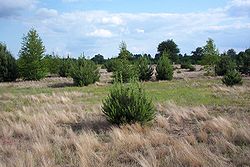Ecological succession
Ecological succession, is how a specific ecology changes after a disturbance, like a fire.[1] In long-term studies, there is a succession in the way forests develop.[2]
Primary succession
Primary succession is the first step of ecological succession. Primary succession happens when new land is formed, allowing it to be colonized for the first time. Primary succession can last up to hundreds or thousands of years.
Examples of primary succession are when lava cools and new rocks are formed, a sand dune forming, glaciers retreating and exposing the soil.
Secondary succession
Secondary succession is the second ecological succession. Secondary succession happens when a climax community or intermediate community is disturbed. It then re-establishes a better version of the community. This can take 50 years or more.
When a forest is cleared by a fire, a flood, epidemic disease, or a pest attack happens, then there is a secondary growth.
Notable ecologists
- Adolphe Dureau de la Malle was the first to use the word succession. He wrote about the process of re-growth after trees in a forest had been cut down.
- Henry David Thoreau described succession in an Oak-Pine forest in "The succession of forest trees" in the year 1859.
- Henry Chandler Cowles developed a formal concept of plant-growth succession. Henry's work was based on studies of sand dunes in Danish by Eugen Warming. Cowles proposed the term sere. This is a repeat of changes which are shown in specific environmental circumstances.[3]
- Frederic Clements proposed a theory that seres were highly predictable.[3]
- Henry Gleason proposed that chance factors were very important, even in highly predicable sere areas.[3]
Ecological Succession Media
Succession after disturbance: a boreal forest one year (left) and two years (right) after a wildfire.
References
- ↑ Connell, Joseph and R. O. Slatyer. (1977). "Mechanisms of succession in natural communities and their role in community stability and organization," The American Naturalist, Vol. 111, Issue 982, pp. 1119–44.
- ↑ McEvoy, Thom. (2004). Positive Impact Forestry, p. 32.
- ↑ 3.0 3.1 3.2 Goldsmith, Edward. "Ecological succession rehabilitated," Archived 2012-04-15 at the Wayback Machine The Ecologist, Vol. 15 ,#3, 1985
Other websites
| Wikimedia Commons has media related to Lua error in Module:Commons_link at line 62: attempt to index field 'wikibase' (a nil value).. |
| The English Wikibooks has more information on: |
- ScienceAid[dead link], "Ecosystems", Succession Archived 2021-05-06 at the Wayback Machine





